Why Small Group Instruction Works
Before diving into specific strategies, let’s understand why small group instruction is worth the effort. Research consistently shows that students learn more effectively in smaller settings where they receive more individualized attention, have increased opportunities to participate, and can engage more deeply with content.
When implemented effectively, small group instruction:
- Allows teachers to target specific skills and learning needs
- Increases student engagement and participation
- Provides more opportunities for immediate feedback
- Creates a safer space for students to ask questions
- Enables more accurate assessment of student understanding
- Builds stronger teacher-student relationships
The key is implementing small group instruction in a way that maximizes these benefits while managing the rest of your classroom effectively. For more insights on differentiated instruction approaches, check out our comprehensive differentiation guide with practical classroom applications.
Strategy 1: Establish Clear Small Group Instruction Routines
The foundation of successful small group instruction is establishing clear, consistent routines. As Valentina Gonzalez notes in her research, “This is make or break. If students understand what small-group time is going to look and sound like, they will be more successful with it.”
Before implementing small groups, take time to explicitly teach your expectations:
What to Teach Students:
- Time frames for each rotation or group session
- Voice levels appropriate for group work
- How to transition between activities
- What to do when they need help
- How to access materials independently
How to Teach Routines:
- Model the entire process with a small group
- Create visual aids and anchor charts
- Practice transitions repeatedly
- Role-play common scenarios
- Provide specific feedback during practice
Investing time upfront to establish these routines will save countless hours throughout the school year. Remember that younger students may need more practice and reinforcement of routines than older students.
Planning Effective Small Group Instruction Sessions
The success of your small group instruction largely depends on thoughtful planning. Unlike whole-class lessons, small group sessions require more targeted preparation focused on specific student needs.
Key Planning Components:
Identify Learning Goals
Start by clearly defining what students should know or be able to do by the end of the session. These goals should be specific, measurable, and aligned with grade-level standards.
Group Formation Strategy
Determine how you’ll group students (by ability, skill need, interest, etc.) and ensure groups remain flexible based on ongoing assessment data.
Activity Sequence
Plan a logical progression of activities that build toward your learning goal, including warm-up, direct instruction, guided practice, and assessment.
When planning your small group instruction, consider creating a simple template that includes:
- Group members and formation rationale
- Specific learning objectives
- Materials needed
- Step-by-step activity sequence
- Assessment method
- Notes for differentiation within the group
Remember that effective planning doesn’t mean rigid implementation. Be prepared to adjust your plan based on how students respond during the session. As you gain experience with small group instruction, you’ll become more adept at making these in-the-moment adjustments.
“Small groups are fluid. They move and change with the time, topic, and needs of the learners.” – Valentina Gonzalez
Organizing Your Classroom for Small Group Instruction
The physical arrangement of your classroom plays a crucial role in the success of small group instruction. A thoughtfully organized space facilitates smooth transitions, minimizes disruptions, and maximizes instructional time.
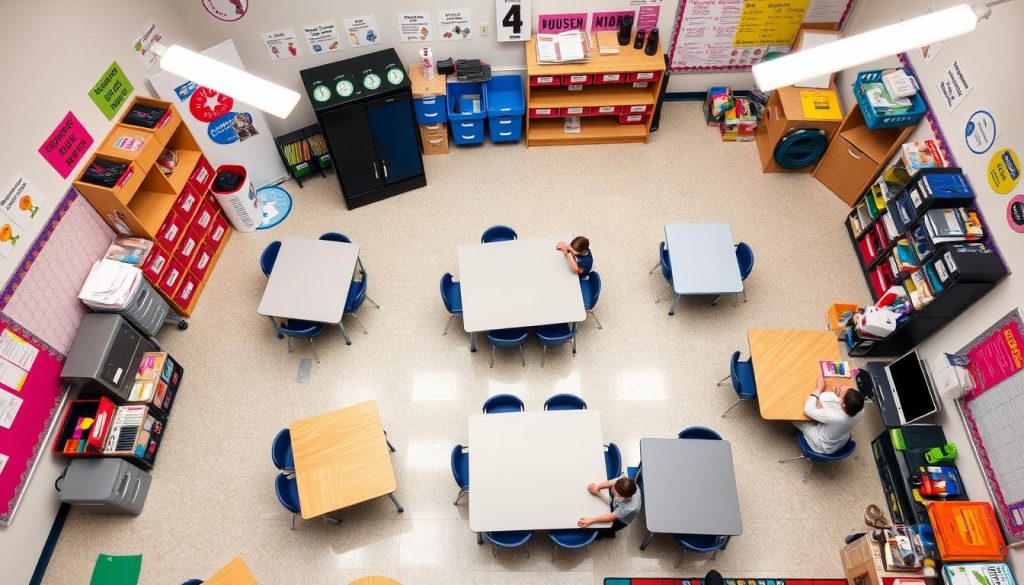
Essential Elements of a Small-Group-Friendly Classroom:
Designated Teacher Area
Create a dedicated space for your teacher-led small group that is positioned to allow you to see the entire classroom while working with your group. This area should have all necessary teaching materials within arm’s reach.
Independent Work Stations
Establish clearly defined areas where students can work independently while you’re with a small group. These stations should be stocked with all necessary materials and have visual instructions posted.
Materials Organization
Use labeled bins, folders, or digital systems to organize materials for each group and activity. Students should be able to access what they need without interrupting your instruction.
Visual Supports
Post schedules, group assignments, and rotation charts where students can easily reference them. Consider using color-coding to help students quickly identify their group and activities.
When organizing your classroom for small group instruction, consider traffic flow carefully. Arrange furniture to create clear pathways that minimize disruptions as students move between activities. Keep high-traffic areas (pencil sharpener, bathroom pass, etc.) away from your small group teaching area.
For more detailed guidance on optimizing your classroom for different instructional approaches, visit our resource hub for classroom arrangement templates and ideas.
Effective Small Group Instruction Grouping Strategies
One of the most powerful aspects of small group instruction is the ability to group students strategically based on their specific needs. However, many teachers fall into the trap of creating static groups that rarely change, which can limit student growth and reinforce labels.
Types of Grouping Strategies:
Ability Grouping
- Groups students with similar skill levels
- Allows for targeted instruction at appropriate pace
- Works well for skills with clear progression
- Should be flexible and regularly reassessed
- Best for foundational skills instruction
Strategy Grouping
- Groups based on specific learning needs
- Focuses on particular skills or strategies
- Can include students of varying overall abilities
- Highly responsive to assessment data
- Ideal for targeted intervention
Interest Grouping
- Groups based on student interests or preferences
- Increases engagement and motivation
- Creates heterogeneous skill groupings
- Promotes peer learning and collaboration
- Great for project-based learning
The key to effective grouping for small group instruction is flexibility. Groups should be formed based on current data and specific instructional purposes, then regularly reassessed and adjusted. As Jenny Vo notes, “Strategy groups are great when you want to provide instruction on a specific skill or strategy… Groups should be short term and should be very fluid.”
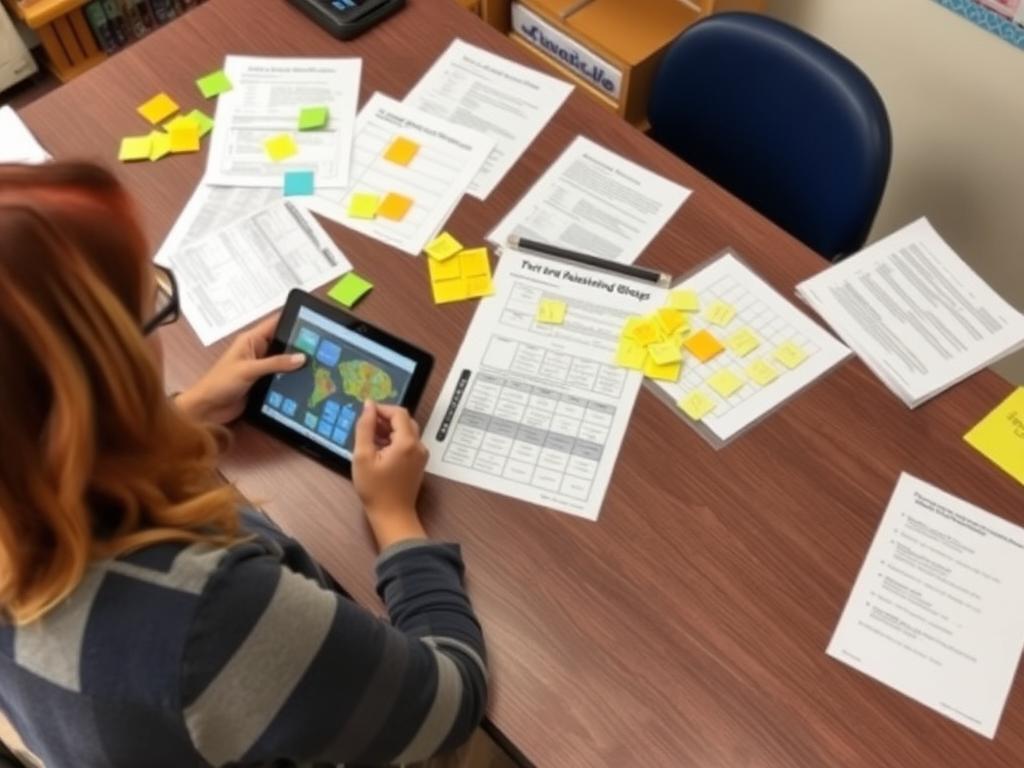
Best Practices for Group Formation:
- Use multiple data points (not just test scores)
- Keep groups small (3-6 students is ideal)
- Document grouping rationales and review regularly
- Avoid having the same students always working together
- Consider social dynamics alongside academic needs
- Plan for different grouping structures throughout the week
Remember that the purpose of small group instruction is to provide targeted support that moves all students forward. Your grouping strategies should reflect this goal by being responsive, purposeful, and dynamic.
Managing the Rest of the Class During Small Group Instruction
One of the biggest challenges of implementing small group instruction is effectively managing what the rest of your students are doing while you work with a small group. Without proper systems in place, this can quickly lead to chaos and interruptions.

Effective Independent Work Activities:
Literacy Stations
- Independent reading with response tasks
- Writing prompts with clear expectations
- Word work and vocabulary activities
- Listening stations with comprehension tasks
- Partner reading with discussion guides
Math Workstations
- Problem-solving tasks with manipulatives
- Math games reinforcing key concepts
- Skill practice with self-checking components
- Real-world application activities
- Math journaling with specific prompts
Cross-Curricular Options
- Research projects with clear checkpoints
- Digital learning platforms with assigned tasks
- STEM challenges with documentation requirements
- Art integration activities connected to content
- Peer tutoring with structured protocols
The key to successful management during small group instruction is ensuring that independent activities are:
- Meaningful – Connected to learning objectives, not just busy work
- Clear – Students understand exactly what to do without needing teacher guidance
- Engaging – Interesting enough to maintain focus for the duration of your small group
- Self-managing – Include self-checking components or clear completion criteria
- Appropriately challenging – Not too difficult to complete independently, but not too easy
Minimizing Interruptions:
Establish a system for students to get help without interrupting your small group instruction. Options include:
- The “Ask 3 Before Me” rule – Students must ask three peers before approaching the teacher
- Question parking lot – A designated space where students can post questions for later
- Help signal cards – Non-verbal cues students can display when they need assistance
- Peer experts – Designated students who can help with specific types of questions
- Timer-based check-ins – Brief whole-class check-in points between groups
Remember that building independence takes time. Start with shorter small group sessions and gradually extend the time as students develop the stamina for independent work.
Maximizing Learning During Small Group Instruction Time
Once you’ve established routines and management systems, it’s time to focus on maximizing the instructional impact of your small group instruction. The limited time you have with each group is precious, so every minute should be purposeful and high-impact.
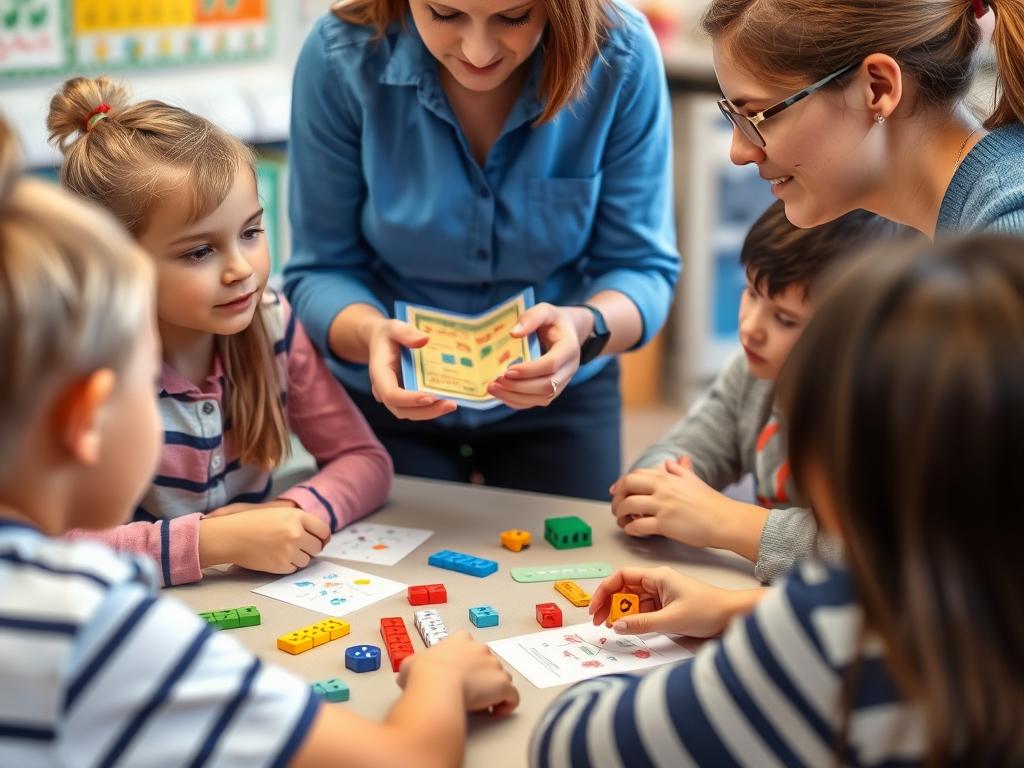
Elements of High-Impact Small Group Lessons:
Clear Focus
Begin each session by explicitly stating what students will be learning and why it matters. This focus should be narrow enough to address in a single session (15-20 minutes).
Targeted Instruction
Provide direct, explicit teaching of skills or concepts tailored to the group’s specific needs. Use clear modeling and think-alouds to make your thinking visible.
Active Engagement
Ensure all students are actively participating throughout the session. Use strategies like choral responses, whiteboards, or response cards to maximize engagement.
Guided Practice
Provide supported opportunities for students to apply what they’re learning with immediate feedback. Gradually release responsibility as students demonstrate understanding.
Formative Assessment
Continuously check for understanding throughout the session. Use this information to make real-time adjustments to your instruction.
Closure
End each session with a quick summary of what was learned and how it connects to previous and future learning. Set clear expectations for applying the learning independently.
The power of small group instruction lies in the opportunity for increased student participation and teacher feedback. In a small group setting, each student should be responding and receiving feedback multiple times throughout the session.
Maximizing Feedback Opportunities:
- Use specific, descriptive feedback rather than generic praise
- Provide immediate correction for errors to prevent misconceptions
- Balance corrective feedback with reinforcement of what students are doing well
- Use a combination of individual and group feedback
- Teach students to provide peer feedback using specific protocols
Remember that effective small group instruction is responsive to student needs in the moment. While you should have a clear plan, be prepared to adjust your pace, examples, or approach based on how students are responding.
For more strategies on maximizing instructional impact through targeted feedback and questioning techniques, explore our Basics of Differentiation Course.
Using Data to Drive Small Group Instruction
Effective small group instruction is fundamentally data-driven. Without meaningful assessment data, it’s impossible to form appropriate groups or target instruction to student needs. Implementing a systematic approach to collecting and using data will dramatically increase the impact of your small group teaching.
Types of Assessment Data for Small Groups:
| Assessment Type | Examples | Best Used For | Frequency |
| Diagnostic | Pre-tests, reading inventories, skill surveys | Initial group formation, identifying specific skill gaps | Beginning of year/unit |
| Formative | Exit tickets, observations, quick checks | Daily/weekly adjustments to groups and instruction | Daily/weekly |
| Progress Monitoring | Running records, fluency checks, skill mastery trackers | Tracking growth over time, determining when to adjust groups | Bi-weekly/monthly |
| Summative | End-of-unit tests, projects, performance tasks | Evaluating overall effectiveness, planning for next units | End of units/quarters |
The key to using data effectively for small group instruction is having a systematic process for collecting, analyzing, and acting on the information. Consider implementing this cycle:
- Collect – Gather meaningful data through various assessment methods
- Analyze – Look for patterns, gaps, and growth opportunities
- Plan – Create targeted lessons based on identified needs
- Implement – Deliver focused instruction in small groups
- Reflect – Evaluate effectiveness and collect new data
Practical Tips for Data Management:
- Create simple tracking systems that are easy to maintain during instruction
- Use color-coding to quickly visualize student progress and needs
- Schedule regular data analysis time in your weekly planning
- Involve students in tracking their own progress when appropriate
- Focus on actionable data that directly informs your instruction
Remember that the purpose of data in small group instruction is not to label students but to provide them with exactly what they need to progress. Keep your data systems flexible and responsive to ensure they serve this purpose effectively.
Differentiating Within Small Group Instruction
Even within your small groups, students will have varying needs, learning styles, and readiness levels. The final strategy for effective small group instruction is differentiating within your groups to ensure every student is appropriately challenged and supported.
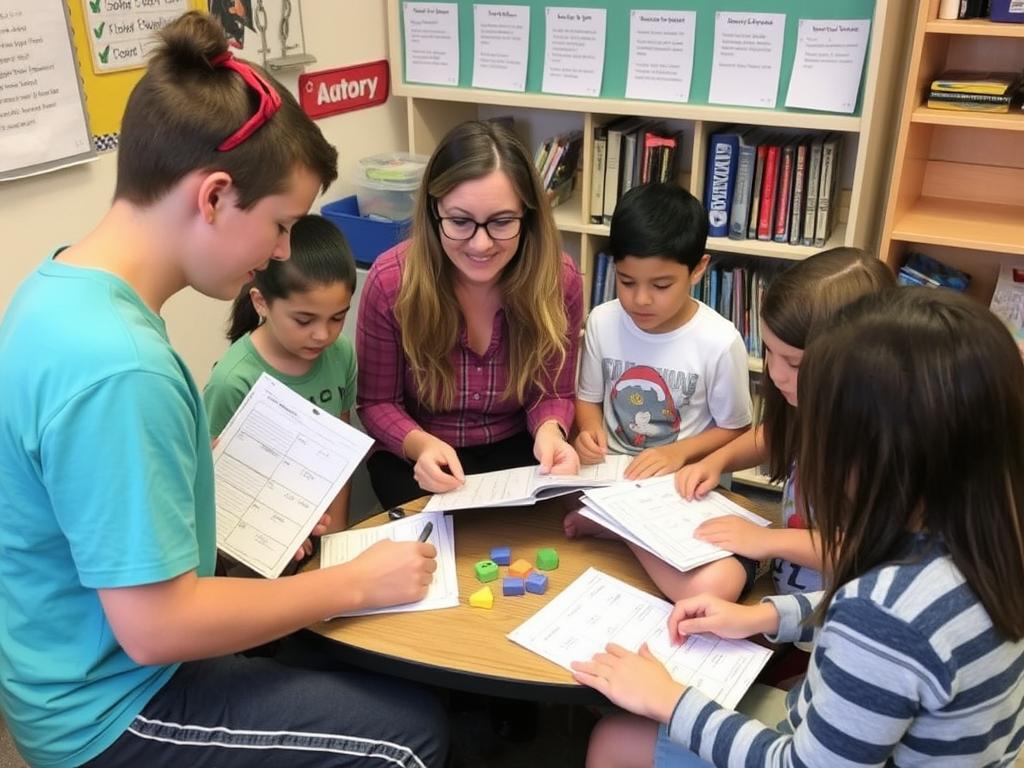
Ways to Differentiate Within Small Groups:
Content Differentiation
Adjust what students are learning based on their readiness levels while maintaining focus on the same core concept.
- Tiered texts at different reading levels
- Varied complexity of problems
- Adjusted scope of content
- Supplementary resources for extension
Process Differentiation
Vary how students engage with and make sense of the content based on their learning preferences.
- Multiple representations of concepts
- Varied questioning techniques
- Flexible pacing within the group
- Different levels of scaffolding
Product Differentiation
Provide options for how students demonstrate their understanding of the content.
- Choice boards for response options
- Varied complexity of outputs
- Multiple modes of expression
- Customized success criteria
Effective differentiation within small group instruction requires thoughtful planning but doesn’t need to be overwhelming. Start with these practical approaches:
Tiered Questions
Prepare questions at different levels of complexity and direct them strategically to different students within the group. This allows all students to participate meaningfully while being appropriately challenged.
Flexible Support
Provide varying levels of scaffolding during the lesson, offering more support to some students while encouraging more independence from others. Gradually adjust this support based on student responses.
Must-Do/May-Do Tasks
Structure activities with core components that all students must complete, followed by extension options for students who finish quickly or need additional challenge.
Strategic Partnering
Thoughtfully pair students within the small group for portions of the lesson to provide peer support and challenge in strategic ways.
For a deeper dive into differentiation strategies that work seamlessly within small group instruction, explore our comprehensive differentiation course with ready-to-use templates and lesson ideas.
Looking for more practical classroom strategies? Check out this excellent Edutopia article on improving small group instruction for additional perspectives and approaches.
Putting It All Together: Your Small Group Instruction Action Plan
Implementing effective small group instruction is a journey, not a destination. The strategies we’ve explored provide a framework for success, but remember that refining your approach is an ongoing process that will evolve with your students’ needs and your growing expertise.
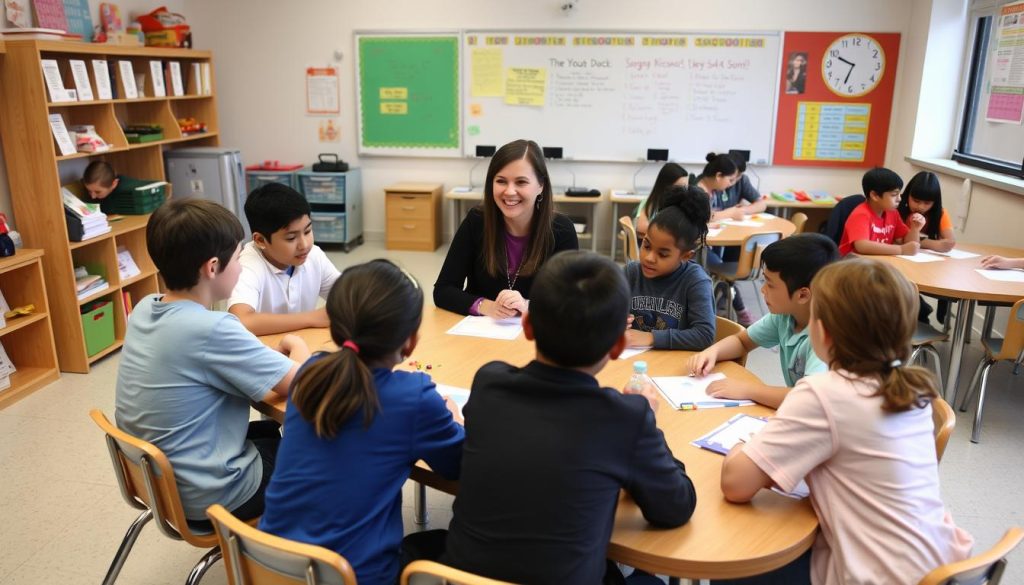
Your Next Steps:
- Start small – Begin with one or two small groups per day and gradually expand
- Focus on routines first – Invest time in teaching expectations before diving into content
- Collect meaningful data – Use simple assessment tools to inform your grouping and instruction
- Reflect regularly – Set aside time to evaluate what’s working and what needs adjustment
- Seek support – Connect with colleagues who are implementing small groups successfully
Remember that effective small group instruction looks different in every classroom. The key is finding an approach that works for your teaching style, your students’ needs, and your curriculum requirements. Be patient with yourself and your students as you refine your practice.
Benefits of Small Group Instruction
- Increased student engagement and participation
- More opportunities for personalized feedback
- Better ability to target specific learning needs
- Stronger teacher-student relationships
- More accurate assessment of student understanding
- Greater student accountability for learning
Challenges to Address
- Managing the rest of the class effectively
- Finding time for planning and preparation
- Maintaining fluid, data-driven groups
- Balancing small group and whole class instruction
- Ensuring independent work is meaningful
- Tracking progress across multiple groups
With thoughtful implementation of these eight strategies, you’ll be well on your way to creating a classroom where small group instruction becomes a powerful tool for student success. Your efforts to provide this targeted, responsive teaching will pay dividends in student engagement, achievement, and confidence.
For more teaching resources, classroom management strategies, and professional development opportunities, visit our resource hub today.




